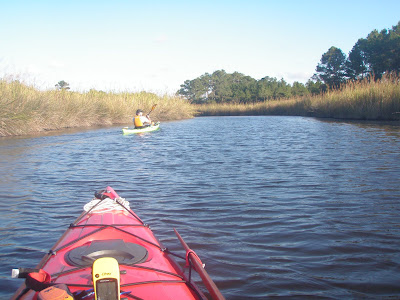
Yes, I think we are ready to paddle. Tent, sleeping bag, air matress, paddling clothes, camp clothes, bad weather clothes, cooking stuff, safety stuff - flares, radio, gps, SPOT, cell phone, spare paddle, etc. And of course a fishing pole & some lures.Today I tried to see if it all fit and it did so I think we're ready to go. David Lyle and I will leave Paterson on Wednesday morning, stay Wednesday night at the home of one of our former deacons, Charles Gaston in Greenville NC. Thursday morning we will go out to Cedar Island in preparation for the inspection in the afternoon and captains meeting at 6:00 p.m. We will be camping overnight at the Driftwood Campground right at the start and begin at 7:30 a.m. Friday morning. There is a detail schedule and narrative of the race on the
Watertribe website. Below is a copy of the map that shows the course of the race. You can track me in two ways. You can go directly to the SPOT tracking site (just click on
SPOT). Here I will be called
Macatawa, which is Ben's paddling name, since I'm using his SPOT - but its really me. Or you can go to the Watertribe Map site - click
HERE.
At this site you will see all of the paddlers. My name is
PassaicPaddler. If you want to just see just me click on that name in the 3rd box and hit "regenerate view". David Lyle is
Summit Paddler.

For all of those who are supporting me to help raise money to purchase kayaks,vests, paddles and a trailer for our Christian Cadet Club, I'm happy to report that I have surpassed my goal with pledges of $55.00 per mile. This will be enough to also purchase new camping and fishing equipement for our new cadet group. Thanks so much to all who made a pledge. Please keep us in your prayers.
 Here are the tools of the trade for joining them together. Small brush, brush on the end of a 4 fts stick and flashlight. I soaked the roll of 2" glass tape in epoxy and started it in the middle of the coaming and rolled them to each end. It really worked well expect on the first one where I didn't measure exactly how much I had on each end and ended up with to much on one side and to little on the other. I was able to simply bury the extra in the ends and add an extra roll on the other side. Live and learn.
Here are the tools of the trade for joining them together. Small brush, brush on the end of a 4 fts stick and flashlight. I soaked the roll of 2" glass tape in epoxy and started it in the middle of the coaming and rolled them to each end. It really worked well expect on the first one where I didn't measure exactly how much I had on each end and ended up with to much on one side and to little on the other. I was able to simply bury the extra in the ends and add an extra roll on the other side. Live and learn. Here are the rolls of tape ready to put into a yogert cup of epoxy. Laying the kayak on it's side works very well and I didn't have a problem sticking my head into each hatch.
Here are the rolls of tape ready to put into a yogert cup of epoxy. Laying the kayak on it's side works very well and I didn't have a problem sticking my head into each hatch.
 Here is the kayak taped with the inside completed. Next steps are to strip off the tape, clean off any glue, sand or plane the edge, add filler to any cracks and repeat the process on the outside. Now I'm getting anxious to go paddling.
Here is the kayak taped with the inside completed. Next steps are to strip off the tape, clean off any glue, sand or plane the edge, add filler to any cracks and repeat the process on the outside. Now I'm getting anxious to go paddling.

















































